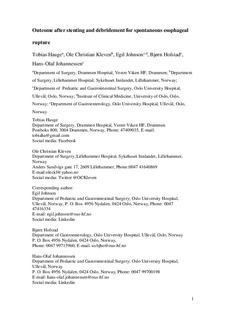| dc.contributor.author | Hauge, Tobias | |
| dc.contributor.author | Kleven, Ole Christian | |
| dc.contributor.author | Johnson, Egil | |
| dc.contributor.author | Hofstad, Bjørn | |
| dc.contributor.author | Johannessen, Hans Olaf | |
| dc.coverage.spatial | Norway | nb_NO |
| dc.date.accessioned | 2019-12-17T10:11:57Z | |
| dc.date.available | 2019-12-17T10:11:57Z | |
| dc.date.created | 2018-07-22T13:28:40Z | |
| dc.date.issued | 2018 | |
| dc.identifier.citation | Scandinavian Journal of Gastroenterology. 2018, 53 (4), 398-402. | nb_NO |
| dc.identifier.issn | 0036-5521 | |
| dc.identifier.uri | http://hdl.handle.net/11250/2633570 | |
| dc.description.abstract | OBJECTIVES:
Surgical repair has been the most common treatment of esophageal effort rupture (Boerhaave syndrome). Stent-induced sealing of the perforation has increasingly been used with promising results. We present our eight years´ experience with stent-based and organ-preserving treatment.
MATERIALS AND METHODS:
Medical records of 15 consecutive patients with Boerhaave syndrome from February 2007 to May 2015 were retrospectively registered in a database. Treatment was sealing of the perforation by stenting, chest tube drainage and débridement of the contaminated thorax. After median 25 months nine out of 10 patients responded to questions on fatigue and Ogilvie's dysphagia score.
RESULTS:
Fifteen patients, aged median 67.5 years (range 39-88), had a primary hospital stay of 20 days (range 1-80 days). Overall in-hospital mortality was 13%. Observation time was 44 months (range 0-87) and 10 patients were alive of August 2017. Ten patients (67%) needed surgical chest débridement. Five patients (33%) were restented for leakage, migration and for stent removal. Eleven patients (73%) had complications, which included pleural empyema (n = 4), fatal aortic bleeding, lung arterial bleeding, lung embolism, drain-induced lung laceration and respiratory failure. Dysphagia score was low (median 0.5) meaning that they were able to feed themselves. Total fatigue score (mean 14.6) was slightly increased (p = .05) compared with a reference population.
CONCLUSIONS:
The mortality rate after initial stenting of effort rupture seems to be comparable to standard surgical repair. Most patients required further intervention, either by restenting and/or surgical débridement. The functional result in these patients was satisfactory. | nb_NO |
| dc.language.iso | eng | nb_NO |
| dc.publisher | Tatlor and Francis Group | nb_NO |
| dc.rights | Navngivelse-Ikkekommersiell-DelPåSammeVilkår 4.0 Internasjonal | * |
| dc.rights.uri | http://creativecommons.org/licenses/by-nc-sa/4.0/deed.no | * |
| dc.subject | Boerhaave syndrome; drainage; dysphagia; débridement; fatigue; stenting | nb_NO |
| dc.title | Outcome after stenting and debridement for spontaneous esophageal rupture | nb_NO |
| dc.title.alternative | Outcome after stenting and debridement for spontaneous esophageal rupture | nb_NO |
| dc.type | Peer reviewed | |
| dc.type | Journal article | |
| dc.description.version | acceptedVersion | nb_NO |
| dc.rights.holder | Ikke OA. Taylor and Francis | nb_NO |
| dc.source.pagenumber | 398-402 | nb_NO |
| dc.source.volume | 53 | nb_NO |
| dc.source.journal | Scandinavian Journal of Gastroenterology | nb_NO |
| dc.source.issue | 4 | nb_NO |
| dc.identifier.doi | 10.1080/00365521.2018.1448886 | |
| dc.identifier.cristin | 1598233 | |
| cristin.unitcode | 1991,6,8,0 | |
| cristin.unitname | Avd Kirurgi | |
| cristin.ispublished | true | |
| cristin.fulltext | postprint | |
| cristin.qualitycode | 1 | |

